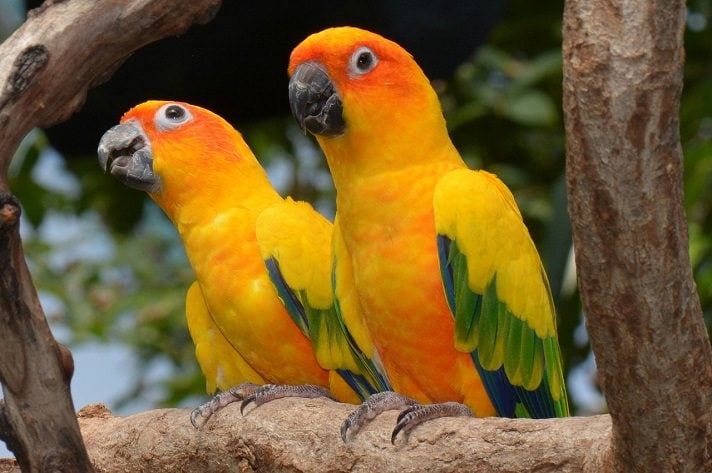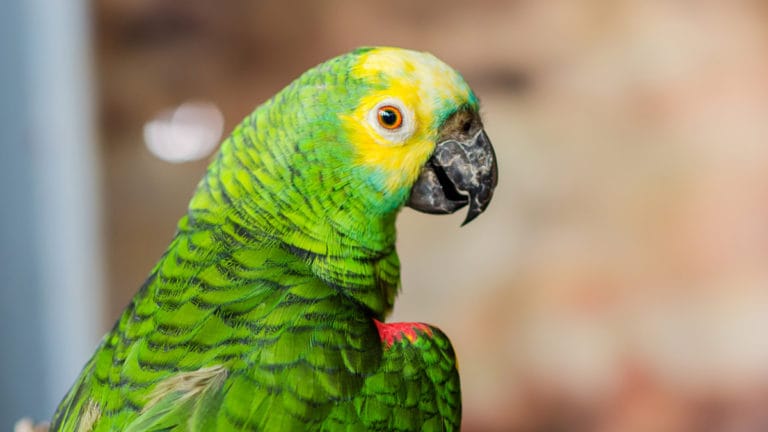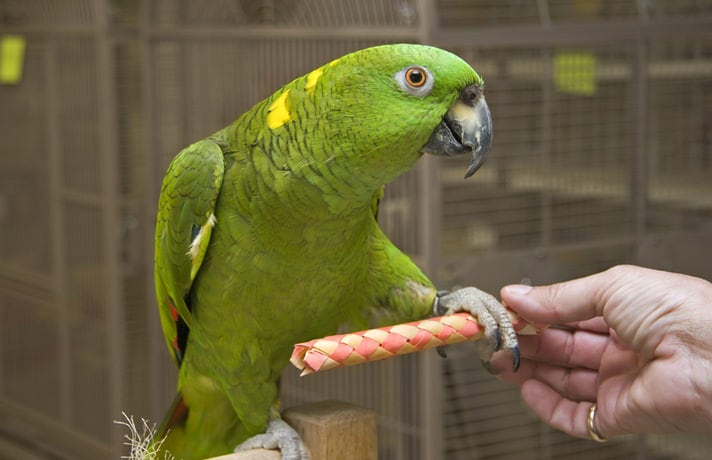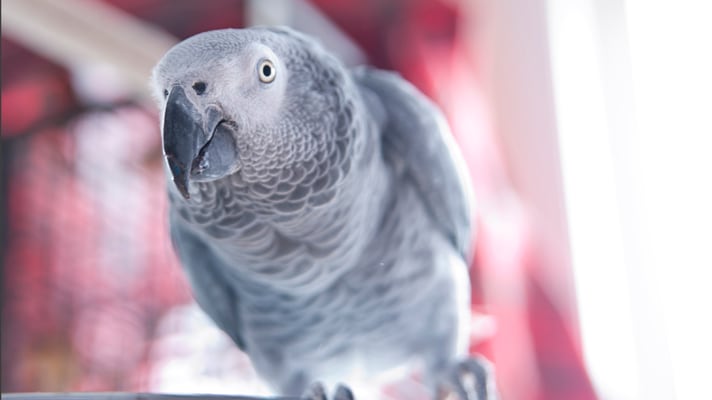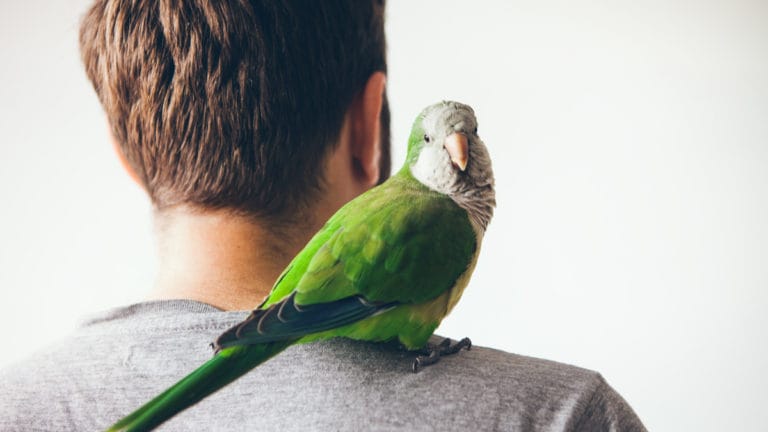Endangered Species Day is on May 17, 2013. Keep checking this list for more parrot information. Learn more about Endangered Species Day at the official website here.
The Lear’s macaw (Anodorhynchus leari) is named after English illustrator and poet Edward Lear. The Lear’s macaw is found only in the state of Bahia in northeastern Brazil. In 2009, it was listed from “critically endangered” to “endangered” by the International Union for Conservation of Nature (IUCN). Many parrot groups are working to help save the Lear’s macaws, from saving the macaw’s primary nesting and roosting cliffs; purchasing and protecting nearly 4,000 acres of habitat to help assure the species’ survival; and running programs like paying farmers to grow corn for Lear’s macaws. The current population estimate of Lear’s macaw is roughly 960 individuals.
Blue-throated macaws (Ara glaucogularis) are critically endangered in their native country of Bolivia, with BirdLife estimating there being only 73 to 87 adults left in the wild. There are conservation programs in the United States dedicated to helping the blue-throated macaws, most notably Bird Endowment. This organization helps blue-throated macaws with a captive breeding program, as well as raising money to supply nest boxes to the Bolvian blues. Recently, the World Parrot Trust has launched a campaign to help promote awareness on the blue-throated macaws’s plight. You can read more here.
The orange-bellied parrot (Neophema chrysogaster) is a bird native to parts of Australia. The orange-bellied parrot is critically endangered —BirdLife.org estimates that there are only 49 mature adults in the population. Due to a number of factors, mostly habitat destruction and introduced bird species competing for food, the orange-bellied parrots’ numbers have dropped rapidly. BirdLife.org estimated in 2010 that the parrots would go extinct in wild in three to five years. A captive-breeding program was started to help boost the wild population, but there hasn’t been much in success. In 2010, the captive orange-bellied parrots were threatened by an unknown virus. There used to be annual releases of captive orange-bellied parrots to help establish a second breeding program with little success. There is an estimated 60 to 170 birds in captivity. The orange-bellied parrot was listed as critically endangered in 2005. It is the only Neophema parrot species to be listed as such under Australia’s Environment Protection and Biodiversity Conservation Act.
The kakapo (Strigops habroptila) is critically endangered. The kakapo is a unique bird: it is the world’s heaviest parrot, and it is flightless. As it evolved in a place with no natural predators, the kakapo was not prepared for the introduced predators that came in with the Polynesians and eventually the Europeans. Cats, stoats, dogs, rats and other predatory mammals found kakapo to be easy meals. Throughout the years, attempts have been made to save the kakapo population from extinction, and in the last few decades, things have turned for the better. From 1995 to 2003, the population of kakapo had grown 62 percent, from 51 birds to 85 birds. Since then, the population has risen to 131 birds. Recent kakapo deaths have dropped the population to 125, however. For more information on the history of the kakapo, check out the Kakapo Recovery Program website here.
The sun conure (Aratinga solstitialis) is a small conure native to South America. It is a very popular pet bird, but in the wild, it is endangered. BirdLife estimates 1,000 to 2,500 adults in the population; the World Parrot Trust lists the sun conure as having a population in the low hundreds. There are two subspecies: A.s. solstitialis and A.s. pintoi, the two groups living in parts of Guyana and Roroaima, Brazil, Surinam and Venezuela. The pet trade and habitat loss have been the greatest factors to the sun conure’s population drop in the last 20 years.
The hyacinth macaw (Anodorhynchus hyacinthinus) is the world’s largest parrot, and is endangered in the wild. BirdLife estimates there are around 4,300 mature adults in the wild; the World Parrot Trust estimates the total population ranges from 2,500 to 10,000 birds. Habitat loss and the pet trade have been the biggest factors to the hyacinth macaw population decline in the wild over the past 45 years. Under Convention on International Trade in Endangered Species of Wild Fauna and Flora (CITES), the hyacinth macaw is listed under Appendix 1, and trade is limited only to special circumstances. The Brazilian and Bolivian government have banned all exports of the hyacinth macaws. The World Parrot Trust and other organizations have encouraged ecotourism in the area to help the species too — if there is demand to visit where these birds live, more efforts will be taken to protect the macaws’ habitat.
The Spix’s macaw (Cyanopsitta spixii) has a tragic story, habitat loss and the pet trade largely driving this bird into extinction in its native home of Bahia, Brazil. By the early 1980s, the Spix’s macaw was thought to be extinct; in 1985, five more birds were discovered, but by 1988, they had disappeared. In 1990, however, one single male Spix’s macaw was discovered, living with an entirely different species, a female Illiger’s macaw (Primolius maracana). In 1995, there was a release of a captive Spix’s macaw female to pair up with the male, and the effort appeared to be successful. That was until the female disappeared seven weeks later, and was later found dead by a farmer. The male Spix’s macaw was last seen in 2000, and the species was believed to be extinct in the wild. There were many birds in captivity however, and, in 1990, they were brought together in an international effort to help preserve the species by the Brazilian Nature Conservation Authority. In 2010, there were 79 macaws in captivity in breeding programs in Germany, Spain, Brazil and Qatar. In total, there are 93 Spix’s macaws in captivity. Recently, Al Wabra Wildlife Preservation, which holds the majority of Spix’s macaws in a breeding program, have started working in the Spix’s macaws’ native lands. They plan to search for any existing Spix’s macaws in the wild, and restoring the land to the original native habitat the Spix’s macaws lived in. Eventually they’ll build a facility to start releasing the Spix’s macaws back into the wild. These plans are still tentative, but there is hope that one day the Spix’s macaw can return to the wild. Did you know? The movie Rio was based on a true story of a Spix’s macaw named Presley, living in the United States. His owner agreed to let Presley join the captive breeding program to help preserve his species.
The maroon-fronted parrot (Rhynchopsitta terrisi) is an endangered parrot native to Mexico. It lives in a small range of 180 miles in the Sierra Madre Oriental, southeastern Coahuila, central-western Nuevo Leon and southwestern Tamaulipas. The parrot’s decline has been due to habitat loss for cattle and agriculture. Droughts in the area have also affected the parrots, as well as annual fires, which have destroyed crucial breeding habitats. BirdLife estimates there are 1,000 to 2,499 adults in the wild; the World Parrot Trust estimates the population to be around 2,500 to 3,000 birds.
The red-fronted macaw (Ara rubrogenys) is a small parrot native to the valleys of Rio Caine and Rio Mizque in Bolivia. It is an endangered, with 670 to 2,700 mature birds, according to BirdLife. The World Parrot Trust estimates the population to be around 1,000 to 4,000 birds. Illegal trade, habitat loss and the birds being considered a crop pest have led to this species’ decline.
The Buffon’s macaw or great green macaw (Ara ambiguus) is an endangered bird native to Central America and South America. There are two subspecies — Ara ambiguus ambiguus and Ara ambiguus guayaquilensis — with the total world population around 1,000 to 2,500 birds. Habitat loss and destruction, the pet trade and the macaws considered a crop pest has led to this species’ decline.
The thick-billed parrot (Rhynchopsitta pachyrhyncha) is an endangered parrot native to Mexico. Bird Life estimates the population 2,000 to 2,800 mature individuals; World Parrot Trust estimates the population to be 1,000 to 4,000 parrots.
The thick-billed parrot used to be native to parts of the United States, one of only two species to the United States. The birds disappeared, likely from hunting. There was an effort to reintroduce captive thick-billed parrots in the Chirichaua Mountains of southeastern Arizona from 1986 to 1993. The efforts failed though — the thick-billed parrots released unable to survive in the wild — and the project was dropped. (You can read an article about that here.) Habitat loss for agriculture reasons are the biggest impacts on the Mexican thick-billed parrot population’s decline today. The World Parrot Trust has partnered with the Instituto Technologico y de Estudios Superiores de Monterrey to help support wild nests. You can read more about the project here.
The golden conure (Guaruba guarouba), also known as the Queen of Bavaria, is an endangered parrot native to Brazil. Habitat loss and the pet trade have led to this species’ decline; according to Bird Life, there is an estimated 600 to 1,700 mature individuals in the wild, with a total of 1,000 to 2,499 parrots overall. The golden conures are communal breeders, with several females carrying over a clutch of eggs they all contributed to. All the adults help care for the young that hatch.
The green-cheeked Amazon (Amazona viridigenalis) is an endangered parrot native to Mexico. The population in Mexico is around 3,000 to 6,500. Habitat loss and the pet trade have contributed to the green-cheeked Amazon’s decline in Mexico. However, the birds are doing well in other habitats, with large naturalized flocks living in southern California, Florida, Puerto Rico, Texas, Hawaii and the West Indies. In Southern California, the parrots’ population is growing and may even outnumber the population in Mexico. These birds live in large flocks during the winter, sometimes seen with different species of Amazons. This parrot is also known as the red-crowned Amazon.
The kaka (Nestor meridionalis) is a parrot native to New Zealand. It is endangered, with a population of 2,500 to 10,000 birds. As with many parrots, habitat loss as contributed to the kakas’ decline, along with introduced mammalian predators. Stoats prey on female kakas that are sitting on eggs, creating a skewed sex ration in the population. Brush-tailed possums prey on nests and also compete with the foods kakas need for breeding. Black rats also cause problems, and introduced wasps compete with the kaka for food sources. Conservation efforts have been initiated that are helping the kaka, including predator control at nests and stoat-proof nest boxes. Residents are urged to plant native tree species for the kaka to feed on and build nests in. Off-site breeding facilities have released kakas into the wild, but there is still a lot that needs to be done to help this parrot species.
The yellow-eared parrot (Ognorhynchus icterotis) is an endangered bird native to parts of South America. The story of the yellow-eared parrot is one of successful. Prior to 1999, the species was considered extinct, until 81 individuals were discovered in Colombia. Habitat loss, the pet trade, hunting for food and the destruction of wax palms, a plant key to the yellow-eared parrot’s survival, had caused the population to drop. After those 81 birds were discovered, conservation efforts were started to help the species. This included campaigns to encourage people not to hunt the birds for food, and habitat restoration for the parrots’ favorite plant: the wax palm. These conservation efforts have helped grown the population to more than 1,000 birds today. In 2010, the yellow-eared parrot was down listed from “critically endangered” to “endangered.” The yellow-eared parrot has had a profound impact on the local communities and conservation as a whole. The parrot has been made the official bird of Municipality of Jardin, Department of Antioquia in Colombia. The yellow-eared parrots’ recovery is considered one of the best conservation efforts in Latin America.
The brown-backed parrotlet (Touit melanonotus) is an endangered parrot native to southeastern Brazil. There are around 250 to 1,000 birds in the wild, their population threatened by habitat destruction for agriculture, urban growth and mining. There are some small subpopulations living in protected areas, and the parrotlets’ are protected under Brazilian law; however, threats remain for this species.
The vinaceous-breasted Amazon (Amazona vinacea) is an endangered parrot. It is native to parts of Brazil, Argentina and Paraguay. There are only 1,000 to 2,500 birds in the wild. Habitat loss for agriculture and colonization and smuggling have decreased the vinaceous-breasted Amazons’ population. These parrots are protected under Brazilian law, with conservation efforts ongoing.
The yellow-headed Amazon (Amazona oratrix), also known as the double yellow-headed Amazon parrot, is an endangered parrot native to Mexico and Central America. It is a popular pet bird, and is known for its outgoing personality, talking ability and love of food. But in the Amazon’s native range, there are only around 7,000 birds. Habitat loss, the pet bird trade, hunting for food and being considered a crop pest has led to this species’ decline. There is hope though: naturalized yellow-headed Amazons have taken roost in areas where it has been introduced, such as Southern California, and the population seems to be thriving.
The grey-cheeked parakeet (Brotogeris pyrrhoptera) is an endangered parrot native to parts of Ecuador and Peru. The population has decreased dramatically in the 20th century; BirdLife.org doesn’t list a population size; the World Parrot Trust lists the the population at around 15,000 birds. Habitat loss, the pet trade and being considered a crop pest have led to this parrots’ steep population decline. They are great pet birds, but hard to find in the United States, as they do not breed well in captivity.
The swift parrot (Lathamus discolor) is an endangered parrot native to Australia. There are only 1,000 to 2,500 of these parrots. The swift parrot breeds in Tasmania, where habitat clearing for agriculture, logging, etc have hurt the Eucalyptus globules trees it breeds in. The birds need nectar in the breeding situation, getting it from flowering Tasmanian blue gum Eucalyptus globules. The availability from the nectar year to year determines if the birds are going to breed that year. As mature trees are cut down, it makes nectar even more unreliable. Competetion for nesting sites and food sources as also brought the swift parrot population down, along with psitttacine beak and feather disease and the bird trade.
TheGirlsNY/Flickr.com The golden-shouldered parrot (Psephotus chrysopterygius) is an endangered parrot native to Australia. There are around 2,000 birds n the wild. They live in Northeastern Australia, in three isolated breeding habitats. Habitat loss was the start of this species’ downfall, cattle moving in and damaging the termite mounds they nest in. The lack of fires regimes, fires that help a habitat, have led to more woodland. The pied butcherbird has come in with the new habitat and preys on the golden-shouldered parrots. BirdLife estimates that one-third of nests lose one or more of the adults to these predators.
The echo parakeet (Psittacula echo) is an endangered parrot native to the island of Mauritius. There are around 500 of these birds in the wild, up from 50 to 61 birds in 1993. Deforestation for plantations reduced the native foods the echo parakeet traditionally fed on, and the population plunged. Introduced predators preyed on the birds, as well as competed for food sources, further hurting the population. Conservation groups stepped in 1973 to help the echo parakeets, and helped bolster the echo parakeets by providing food and nest boxes, keeping predators at bay, creating a national park in the parakeets’ foraging area and starting a captive breeding program. Going forward, the conservation groups hope to reintroduce the echo parakeets to other areas in the island, as well as introducing birds to the nearby island Reunion.
By: Jessica Pineda
Featured Image: Via SHAWSHANK61/Pixabay
Share:
